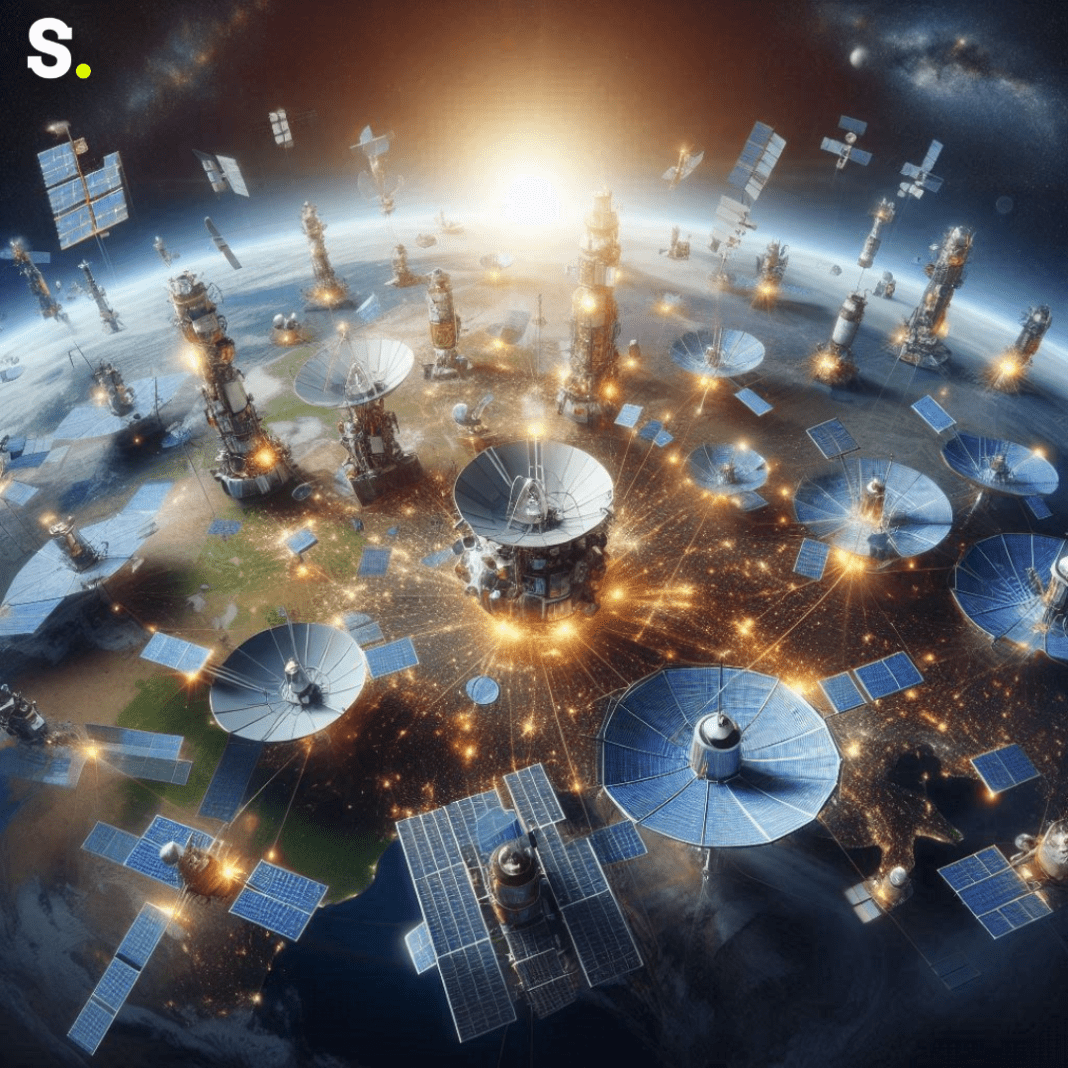Commercial satellite services encompass a wide range of applications that leverage satellite technology for various purposes. These services are integral to modern life, supporting telecommunications, Earth observation, and navigation and positioning systems. Each of these areas plays a crucial role in various industries and applications, underscoring the importance of satellites in our interconnected world.
Telecommunications: Bridging Global Gaps
Commercial satellites are indispensable for global telecommunications. They provide communication services over vast distances where traditional terrestrial infrastructure is impractical or unavailable. This capability is crucial for maintaining connectivity in remote regions, over oceans, and in the air. Here’s a closer look at their role:
Voice Communication and Internet Connectivity
Satellites facilitate voice communication and internet connectivity for businesses, governments, and individuals worldwide. In regions where laying cables is either too costly or logistically impossible, satellites step in to provide reliable communication channels. For instance, rural areas, isolated islands, and ships at sea rely on satellite links for essential communication services.
Television Broadcasting and Data Transmission
Satellite technology also underpins global television broadcasting. Direct-to-home satellite TV services bring a wide range of channels to viewers, often in regions with limited access to cable TV. Furthermore, satellites support data transmission for various applications, including banking transactions, remote education, and telemedicine. This connectivity ensures that even the most remote areas can access critical services and information.
Indispensable for Specific Industries
Certain industries are particularly dependent on satellite telecommunications. The maritime industry, for example, uses satellites for navigation, communication, and weather forecasting, which are crucial for safe and efficient operations at sea. Aviation also benefits from satellite communication systems, which provide connectivity for passengers and critical data links for pilots and air traffic controllers. Additionally, rural connectivity initiatives leverage satellites to bridge the digital divide, providing internet access to underserved communities.
Earth Observation: Monitoring Our Planet
Earth observation satellites capture high-resolution imagery and data of the Earth’s surface, atmosphere, and oceans from space. This data is vital for monitoring environmental changes, weather patterns, natural disasters, urban development, agriculture, and resource management. Here’s how Earth observation satellites contribute:
Environmental Monitoring and Climate Change
Earth observation satellites play a pivotal role in monitoring environmental changes and climate patterns. By capturing detailed images and data, these satellites help track deforestation, glacier melting, sea-level rise, and changes in land use. This information is crucial for scientists and policymakers working to understand and mitigate the impacts of climate change. For example, satellites can monitor carbon emissions and their effects on the atmosphere, providing data that supports international climate agreements and initiatives.
Disaster Management
In times of natural disasters, Earth observation satellites provide real-time data that is essential for effective disaster management. Satellites can quickly assess the extent of damage from events such as hurricanes, earthquakes, floods, and wildfires. This information enables emergency responders to allocate resources more effectively and plan evacuation routes. For instance, during the 2019 Amazon rainforest fires, satellite imagery was instrumental in identifying affected areas and coordinating firefighting efforts.
Urban Planning and Agriculture
Urban planners use satellite data to monitor and manage the growth of cities. High-resolution images help track infrastructure development, land use changes, and population density. This information is vital for making informed decisions about urban expansion, transportation networks, and public services. In agriculture, satellites provide data on crop health, soil moisture, and weather conditions. Farmers can use this information to optimize irrigation, reduce pesticide use, and improve crop yields. For example, precision agriculture relies on satellite data to monitor fields and manage resources more efficiently.
Navigation and Positioning: Precision and Reliability
Navigation and positioning satellites provide accurate location and timing information globally through systems like GPS (Global Positioning System), GLONASS (Global Navigation Satellite System), Galileo (European Union), and BeiDou (China). These systems are critical for various applications:
Transportation and Logistics
Navigation satellites ensure the safety and efficiency of transportation systems worldwide. In aviation, GPS enables precise flight navigation, reducing the risk of accidents and improving fuel efficiency. Maritime navigation also relies on satellite positioning to chart safe and efficient routes. On land, logistics companies use satellite navigation to optimize delivery routes, reducing costs and improving customer satisfaction. For example, GPS-enabled fleet management systems help companies track and manage their vehicles in real time.
Surveying and Mapping
Surveyors and cartographers use satellite positioning systems for accurate measurements and mapping. This capability is essential for construction projects, land development, and infrastructure planning. High-precision satellite data ensures that maps and plans are accurate, which is crucial for avoiding costly mistakes. For instance, in large-scale construction projects like highways and bridges, precise measurements are necessary to ensure structural integrity and safety.
Geolocation-Based Services
Geolocation-based services, such as ride-sharing apps and fitness tracking devices, rely on satellite positioning for accurate location data. These services have become integral to everyday life, providing convenience and enhancing safety. Ride-sharing apps like Uber and Lyft use GPS to match drivers with passengers and provide accurate arrival times. Fitness tracking devices use satellite data to monitor physical activities like running and cycling, offering users detailed insights into their performance.
The Vulnerability of Commercial Satellite Services
While commercial satellite services are vital, they are not without vulnerabilities. Satellites in space are susceptible to various threats, including space debris, cyberattacks, and anti-satellite (ASAT) weapons. These threats pose significant risks to the continuity and reliability of satellite services.
Space Debris
The growing amount of space debris poses a significant threat to satellites. Collisions with debris can damage or destroy satellites, disrupting communication, navigation, and Earth observation services. Efforts are underway to mitigate this risk, including developing technologies to track and remove debris from orbit.
Clearing the Cosmos: Taming Space Debris
Cybersecurity Threats
Satellites and ground stations are also vulnerable to cyberattacks. Hackers can potentially take control of satellites, intercept data, or disrupt services. Ensuring robust cybersecurity measures is essential to protect these critical infrastructures.
Anti-Satellite Weapons
The development and testing of anti-satellite weapons by various countries have raised concerns about the potential for conflicts in space. These weapons can disable or destroy satellites, disrupting services and posing risks to national security and economic stability.
Commercial satellite services play a pivotal role in facilitating global connectivity, monitoring the Earth’s environment, and providing essential navigation and positioning capabilities across diverse industries and applications. However, their importance also makes them vulnerable to various threats. As the reliance on satellite technology continues to grow, it is crucial to address these vulnerabilities to ensure the continued availability and reliability of these vital services. The future of global communication, environmental monitoring, and navigation depends on the resilience and security of our satellite infrastructure.




